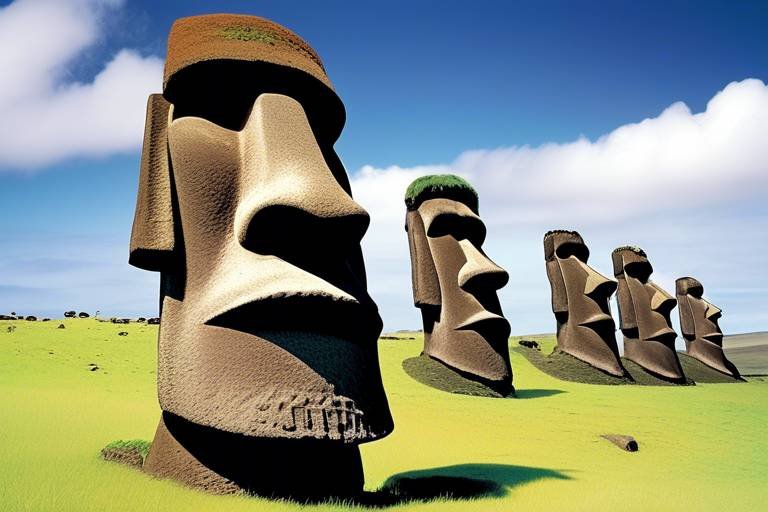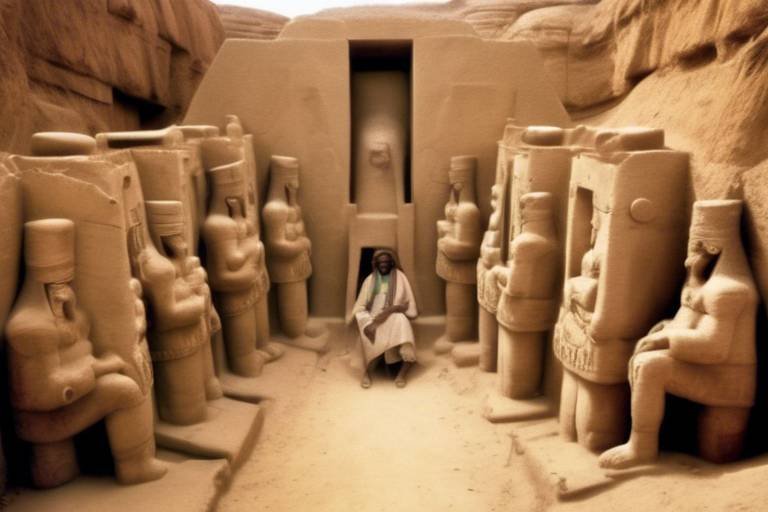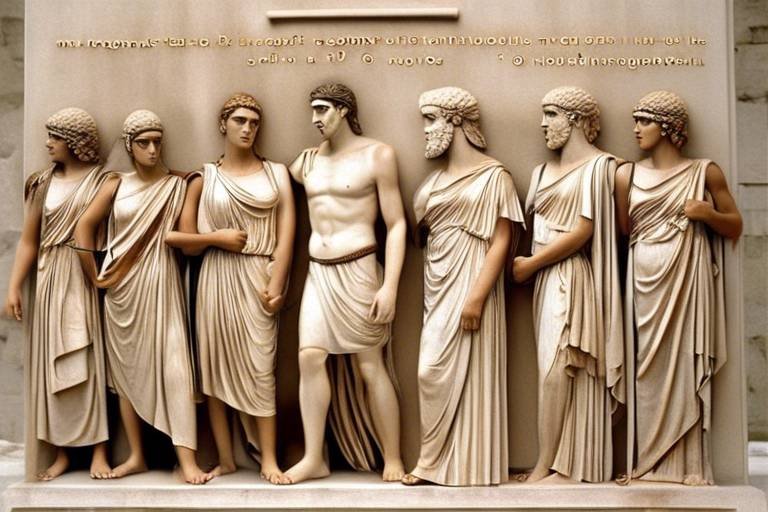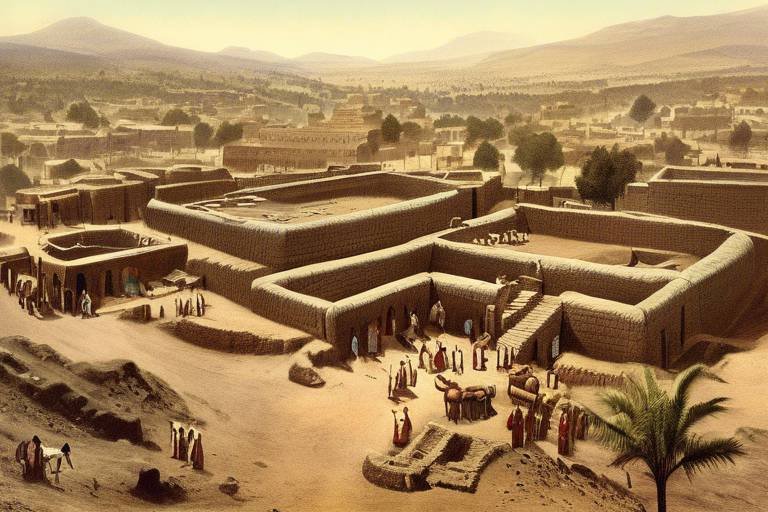The Forgotten Achievements of the Pre-Columbian Civilizations
The Pre-Columbian civilizations in the Americas were not only rich in culture and tradition but also made significant advancements in various fields that are often overlooked in history. These ancient societies, flourishing before the arrival of Christopher Columbus, left behind a legacy of innovation and achievement that continues to fascinate historians and archaeologists to this day.
One of the most renowned civilizations of the Pre-Columbian era is the Mayan civilization. The Mayans were pioneers in developing a sophisticated calendar system that accurately predicted celestial events. Their impressive city-states, such as Tikal and Palenque, showcased intricate architecture and urban planning. Additionally, the Mayans made remarkable advancements in mathematics and astronomy, laying the foundation for future scientific discoveries.
Another formidable empire of the ancient Americas was the Aztec Empire in Mesoamerica. Known for their military prowess and conquests, the Aztecs built a complex social structure with a powerful ruling class. Their monumental architecture, including the iconic Templo Mayor in Tenochtitlan, reflected their religious beliefs and cultural sophistication.
The Inca Empire in South America is celebrated for its engineering marvels, particularly the extensive road network that connected distant regions of the empire. The agricultural terraces of the Incas demonstrated their ingenuity in adapting to diverse environments, while the breathtaking citadel of Machu Picchu stands as a testament to their architectural prowess.
Turning our attention to North America, the Mississippian culture thrived in the Eastern Woodlands, known for their mound-building societies. These complex civilizations exhibited advanced social organization, innovative agricultural techniques, and distinctive art styles that reflected their cultural identity.
Further south, the Chavin culture in the Andes region of South America left a lasting impact with its intricate stone carvings and religious significance. The early urban planning of the Chavin people laid the groundwork for future urban centers in the region, showcasing their advanced architectural knowledge.
The Teotihuacan civilization in present-day Mexico left behind monumental pyramids and intricate urban planning that influenced subsequent Mesoamerican cultures. The city of Teotihuacan, with its grandeur and sophistication, remains a testament to the engineering skills and cultural achievements of its inhabitants.
Along the northern coast of Peru, the Moche civilization flourished with its artistic achievements and advanced metalworking techniques. The Moche people developed elaborate irrigation systems to support their agriculture, showcasing their ingenuity in harnessing natural resources for societal development.
Lastly, the Hopewell culture in the Eastern Woodlands of North America is known for its elaborate earthworks, extensive trade networks, and ceremonial sites. The intricate geometric earthworks of the Hopewell people reflect their spiritual beliefs and organizational skills, highlighting the sophistication of their society.

Mayan Civilization
The Mayan civilization, one of the most advanced ancient societies in the Americas, left a lasting legacy of remarkable achievements in various fields. Known for their intricate calendar system, the Mayans developed a sophisticated way of tracking time that surpassed many other civilizations of their time. This calendar, based on precise astronomical observations, allowed them to predict celestial events with astonishing accuracy.
Moreover, the Mayans built impressive city-states that served as centers of political, religious, and economic activities. These urban centers were characterized by monumental architecture, such as towering pyramids and elaborate palaces, showcasing the engineering and artistic skills of the Mayan people.
In addition to their architectural prowess, the Mayans made significant advancements in mathematics and astronomy. They developed a complex numerical system, including the concept of zero, which enabled them to perform intricate calculations and create precise astronomical charts. Their understanding of celestial movements and cycles was crucial for agricultural planning and religious ceremonies.
Furthermore, the Mayans were skilled astronomers who studied the movements of the stars, planets, and the sun. They built observatories to track celestial events and align their structures with astronomical phenomena. This knowledge not only shaped their religious beliefs but also influenced their agricultural practices and societal organization.

Aztec Empire
The Aztec Empire, one of the most powerful Mesoamerican civilizations, flourished in the central region of Mexico from the 14th to the 16th centuries. Known for their military prowess and complex social structure, the Aztecs created a sophisticated society that left a lasting impact on the region.
At the heart of the Aztec Empire was their capital city of Tenochtitlan, built on an island in the middle of Lake Texcoco. The city was a marvel of engineering, featuring intricate canal systems and impressive stone architecture. The Aztecs constructed monumental temples and palaces, showcasing their advanced architectural skills and religious dedication.
One of the key aspects of the Aztec Empire was its intricate social hierarchy. At the top of the hierarchy was the emperor, who held both political and religious power. Below the emperor were nobles, priests, and warriors, each playing a vital role in maintaining the empire's stability and prosperity.
Moreover, the Aztecs were known for their elaborate religious practices, including human sacrifice as offerings to their gods. These rituals were central to Aztec beliefs and were performed regularly in grand ceremonies at the empire's temples.
Trade also played a significant role in the Aztec Empire's economy. The Aztecs established extensive trade networks, exchanging goods such as food, textiles, and precious metals with neighboring regions. This trade helped the empire prosper and facilitated the exchange of ideas and cultural practices.
Despite their impressive achievements, the Aztec Empire met a tragic end with the arrival of Spanish conquistadors led by Hernan Cortes in the early 16th century. The conquest of the Aztec Empire marked the beginning of the end for one of the most advanced civilizations in the Americas, leaving behind a rich legacy of art, architecture, and cultural practices.

Inca Empire
The was a marvel of engineering and innovation that flourished in the Andes region of South America. Known for their incredible architectural feats, the Incas built an extensive road network that spanned thousands of miles, connecting their vast empire. These roads were not only used for transportation but also for communication and trade, showcasing the strategic planning and organizational skills of the Inca civilization.
One of the most iconic legacies of the Inca Empire is Machu Picchu, a breathtaking citadel perched high in the Andes mountains. This architectural wonder served as a royal estate for Inca emperors and is a testament to the advanced building techniques of the Incas. The precision of the stonework, the intricate terraces for agriculture, and the sophisticated water management systems at Machu Picchu continue to astound visitors to this day.
Aside from their architectural prowess, the Incas were also skilled agriculturalists. They developed innovative farming techniques to adapt to the challenging terrain of the Andes, such as terraced farming and irrigation systems. These agricultural innovations allowed the Inca Empire to sustain a large population and thrive in a region where farming would have otherwise been difficult.
Moreover, the Inca civilization had a complex social structure that was tightly intertwined with their religious beliefs. The ruler, known as the Sapa Inca, was considered divine and held absolute power over the empire. Religion played a central role in Inca society, with rituals and ceremonies conducted to honor their gods and ancestors.
Trade was also a crucial aspect of the Inca Empire's economy. Despite not having a system of currency, the Incas established a vast network of trade routes that facilitated the exchange of goods across different regions. This enabled the empire to access a wide variety of resources and luxury items, further enhancing their cultural and economic prosperity.
In conclusion, the Inca Empire stands as a testament to the ingenuity and resilience of ancient civilizations in the Americas. Their remarkable achievements in engineering, agriculture, and social organization continue to captivate historians and archaeologists, shedding light on the rich cultural heritage of the Andean peoples.

Mississippian Culture
The Mississippian culture flourished between the 9th and 16th centuries in the Mississippi River Valley and southeastern United States. Known for their distinctive mound-building practices, these societies created impressive earthen structures that served various purposes, including ceremonial, residential, and burial sites. The intricate network of mounds reflected the complex social organization and religious beliefs of the Mississippian people.
One of the most famous sites associated with the Mississippian culture is Cahokia, located near present-day St. Louis, Missouri. Cahokia was one of the largest urban centers of its time in North America, with a population estimated to be as high as 20,000 at its peak. The site featured a massive central mound known as Monk's Mound, which served as the focal point of the city and a platform for important ceremonies and gatherings.
Art played a significant role in Mississippian society, with elaborate pottery, sculptures, and other artifacts showcasing the artistic skills of these ancient peoples. The distinctive shell-tempered pottery, adorned with intricate designs and symbols, is a hallmark of Mississippian artistry. These artifacts provide valuable insights into the cultural practices and beliefs of the Mississippian people.
In addition to their artistic achievements, the Mississippian culture made significant advancements in agriculture. Maize, beans, and squash were staple crops cultivated by these societies, supporting their growing populations. The development of efficient agricultural techniques, such as crop rotation and soil fertilization, enabled the Mississippian people to sustain their settlements and thrive in the challenging environment of the Mississippi River Valley.
The Mississippian culture was characterized by long-distance trade networks that facilitated the exchange of goods, ideas, and technologies across vast distances. Copper, mica, marine shells, and other valuable materials were traded among different Mississippian communities, creating a network of economic and cultural exchange. This interconnectedness contributed to the cultural diversity and richness of the Mississippian societies.

Chavin Culture
The Chavin culture, one of the most ancient civilizations in the Andes region of South America, holds a significant place in the history of pre-Columbian societies. Known for its religious significance and intricate stone carvings, the Chavin culture flourished between 900 and 200 BCE. The Chavin people were pioneers in early urban planning, creating complex ceremonial centers that showcased their advanced architectural skills.
At the heart of the Chavin culture was their religious beliefs, centered around a powerful deity depicted as a feline-human hybrid. This god, often portrayed with ferocious fangs and expressive eyes, symbolized the dual nature of the spiritual world and the physical realm. The Chavin people constructed temples and monuments adorned with elaborate stone carvings, reflecting their deep connection to the supernatural.
The Chavin deities were not only worshipped but also feared, with rituals involving hallucinogenic substances believed to facilitate communication with the spiritual realm. Shamans played a crucial role in these ceremonies, guiding the community in their quest for divine wisdom and protection. The Chavin culture's religious practices influenced subsequent civilizations in the Andean region, leaving a lasting legacy in the spiritual beliefs of the indigenous peoples.
Archaeological excavations have revealed the intricate network of underground passages and galleries at the Chavin de Huantar site, a monumental ceremonial center that served as the cultural and religious hub of the Chavin civilization. The site's architectural layout, featuring plazas, temples, and drainage systems, showcases the advanced engineering skills of the Chavin people.
Moreover, the Chavin culture's mastery of stone carving is evident in the intricate designs found on steles, obelisks, and sculptures discovered at various archaeological sites. These artistic expressions not only served as religious symbols but also conveyed narratives of mythical creatures, rituals, and cosmological beliefs that were integral to the Chavin worldview.
In conclusion, the Chavin culture's contributions to ancient Andean civilization are profound and enduring. Their innovative architectural designs, intricate stone carvings, and spiritual beliefs continue to fascinate archaeologists and historians, shedding light on the rich cultural tapestry of pre-Columbian societies in South America.

Teotihuacan Civilization
The Teotihuacan civilization, a pre-Columbian society located in present-day Mexico, stands as a testament to the ingenuity and architectural prowess of ancient Mesoamerican cultures. At its peak, Teotihuacan was one of the largest cities in the world, boasting massive pyramids, intricate urban planning, and a rich cultural heritage that influenced subsequent civilizations in the region.
Central to the Teotihuacan civilization were its monumental pyramids, most notably the Pyramid of the Sun and the Pyramid of the Moon. These imposing structures served as religious and ceremonial centers, reflecting the society's complex belief systems and reverence for celestial bodies. The precise alignment of these pyramids with astronomical phenomena highlights the advanced knowledge of the Teotihuacanos in astronomy and urban planning.
Urban planning was a key aspect of Teotihuacan society, with the city laid out in a grid pattern that emphasized symmetry and order. The Avenue of the Dead, a central thoroughfare lined with temples, palaces, and residential complexes, served as the backbone of the city's layout and provided a glimpse into the daily life of its inhabitants.
Art and symbolism played a significant role in the Teotihuacan civilization, as evidenced by the intricate murals, pottery, and carvings found throughout the city. These artistic expressions depicted religious ceremonies, mythological narratives, and everyday activities, offering valuable insights into the cultural practices and beliefs of the Teotihuacanos.
The influence of the Teotihuacan civilization extended beyond its borders, shaping the artistic styles, architectural techniques, and religious practices of neighboring Mesoamerican cultures. The legacy of Teotihuacan can be seen in the iconography of later civilizations such as the Aztecs, who revered the city as a sacred site and incorporated its symbolism into their own religious beliefs.

Moche Civilization
The Moche civilization, flourishing along the northern coast of Peru, was a fascinating ancient society known for its remarkable artistic achievements and advanced metalworking techniques. The Moche people were skilled craftsmen, creating intricate pottery that depicted scenes of everyday life, religious rituals, and mythical beings with astonishing detail. Their pottery was not only aesthetically pleasing but also served as a valuable historical record of their culture and beliefs.
One of the most impressive aspects of the Moche civilization was their mastery of metalworking. They crafted intricate gold and silver ornaments, ceremonial objects, and tools using sophisticated techniques that showcased their advanced metallurgical skills. The intricate designs and craftsmanship of Moche metalwork reflected their reverence for precious metals and their artistic ingenuity.
Moreover, the Moche civilization was renowned for its elaborate irrigation systems that allowed them to cultivate crops in the arid coastal desert region where they resided. They engineered canals and irrigation channels to harness water from rivers and streams, enabling agricultural productivity and sustaining their population. The ingenuity of the Moche in managing water resources was crucial for the success and sustainability of their society.
Additionally, the Moche people constructed impressive adobe pyramids and complex urban centers that showcased their architectural prowess. The Huaca del Sol and Huaca de la Luna are iconic pyramid temples built by the Moche, serving as religious and ceremonial centers that reflected their spiritual beliefs and social organization. These monumental structures stood as testaments to the engineering skill and cultural sophistication of the Moche civilization.
In conclusion, the Moche civilization left a lasting legacy through their artistic achievements, technological innovations, and architectural marvels. Their intricate pottery, advanced metalworking techniques, sophisticated irrigation systems, and monumental structures attest to the creativity, skill, and ingenuity of the Moche people, enriching our understanding of the ancient civilizations of the Americas.

Hopewell Culture
The Hopewell culture, flourishing in the Eastern Woodlands of North America between 200 BCE and 500 CE, is renowned for its elaborate earthworks, intricate artistry, and extensive trade networks. This ancient civilization, named after a farm in Ohio where its artifacts were first discovered, left a lasting impact on the region with its ceremonial mounds and geometric earthworks.
One of the most striking features of the Hopewell culture is the construction of massive earthworks, including geometric enclosures and burial mounds. These earthworks, often aligned with celestial events, served as ceremonial sites for the community, showcasing their advanced understanding of astronomy and geometry.
The intricate artistry of the Hopewell people is evident in their elaborate pottery, intricate jewelry, and finely crafted effigy pipes. These artifacts not only demonstrate the artistic skills of the culture but also provide insights into their beliefs, rituals, and social structures.
Moreover, the Hopewell culture was known for its extensive trade networks, spanning hundreds of miles across the Eastern Woodlands and beyond. Through these networks, the Hopewell people exchanged exotic goods such as copper, mica, and marine shells, showcasing their economic prowess and cultural connections.
Overall, the Hopewell culture represents a fascinating chapter in the pre-Columbian history of North America, characterized by its impressive earthworks, intricate artistry, and extensive trade networks that highlight the sophistication and complexity of this ancient civilization.
Frequently Asked Questions
- What were some of the key achievements of the Mayan civilization?
The Mayan civilization was known for its sophisticated calendar system, impressive city-states, and advancements in mathematics and astronomy.
- What characterized the Aztec Empire?
The Aztec Empire was known for its military prowess, intricate social structure, and monumental architecture in Mesoamerica.
- What engineering marvels are associated with the Inca Empire?
The Inca Empire is renowned for its impressive road network, agricultural terraces, and the architectural wonder of Machu Picchu.
- What defined the Mississippian Culture?
The Mississippian culture was known for its complex social organization, agricultural innovations, and unique art styles, particularly in mound-building societies.
- What are some notable aspects of the Chavin Culture?
The Chavin culture is known for its religious significance, intricate stone carvings, and early urban planning in the Andes region of South America.
- What were the main features of the Teotihuacan civilization?
The Teotihuacan civilization is renowned for its massive pyramids, urban planning, and influence on subsequent Mesoamerican cultures.
- What were the artistic achievements of the Moche civilization?
The Moche civilization excelled in artistic achievements, advanced metalworking techniques, and elaborate irrigation systems along the northern coast of Peru.
- What characterized the Hopewell Culture?
The Hopewell culture is known for its elaborate earthworks, long-distance trade networks, and ceremonial sites in the Eastern Woodlands of North America.



















